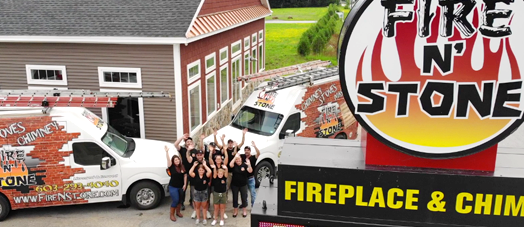Operating Your New Fireplace
Congratulations on the addition of a new fireplace to your home! It will bring you both warmth and ambiance. A fireplace can be transformative and make your home feel cozier and, yes, like home. You will find your family will spend hours in front of your fireplace during the winter months. So, with that idea in mind, here’s a comprehensive guide on operating your new fireplace.
 Know Your Type of Fireplace
Know Your Type of Fireplace
There are three main types of fireplaces, and your new fireplace is probably one of these three-
Traditional Wood-Burning Fireplace
This is the classic fireplace that uses logs as fuel. It requires a masonry chimney for the smoke to escape. It is vital that you have this type of fireplace inspected and cleaned at least once a year. Why? The answer is creosote, a sticky black substance that builds up inside your chimney each time you burn logs. Creosote is highly flammable and, if not dealt with, could cause a chimney fire or even a house fire. You will also want to place a screen in front of your fireplace if not equipped with glass doors to shield the room from smoke and popping embers that could wind up on carpet or furniture.
Gas Fireplace
Operated by natural gas, it’s more convenient than wood-burning types and can be ignited with a switch or remote. If you want the feel of a wood-burning fireplace, artificial logs are available that are vented to let gas through and give the illusion of burning wood.
Electric Fireplace
These units produce heat through electricity and emulate the flame effect. No actual flames are involved, making them the safest option.
Put Fireplace Safety First
Keep Combustibles Away
Ensure that curtains, furniture, and other flammable materials are at a safe distance. It is also wise to keep anything combustible off your fireplace’s mantle. It could mean disaster if it is knocked off the mantle and lands in the flames.
Regular Inspections
As we previously stated, for wood and gas fireplaces, have a professional chimney sweep service inspect and clean your chimney annually. Summer is the best time of year, so it’s ready when cold weather comes around.

Keep Kids & Pets Away
Always supervise your children and pets when the fireplace is active. The flames are mesmerizing, and the temptation to explore your fireplace may prove too much for some kids and, yes, some pets.
Fire Extinguisher
Keep one nearby and ensure it’s in working order.
Carbon Monoxide Detectors
Wood-burning fireplaces produce carbon monoxide, which escapes up the chimney, but if there is a blockage, the deadly gas can enter your home. Place a carbon monoxide detector about fifteen feet from the fireplace to protect your family and pets.
Operating a Wood-Burning Fireplace
Open the Damper
Before lighting, ensure the damper (or chimney flue) is open to allow smoke to exit.
Prime the Flue
Light a rolled-up newspaper and hold it to the open damper to warm up the flue.
Build the Fire
Start with newspaper or kindling at the bottom. Add small logs, then larger ones. Remember: Hot air rises, so your larger logs should be on top for a longer-lasting fire.
Light the Fire
Use a long match or lighter.
Maintain the Fire
Add logs as needed, and use fireplace tools to rearrange logs for better airflow.
Put out the Fire
Let it die down naturally. Spread out ashes to cool. Do not close the damper until all embers are fully extinguished.
Operating a Gas Fireplace
Check the Vents
Ensure they are unblocked.
Open the Damper
If your unit has one.
Ignition
Turn on the gas and use the igniter switch or remote. Some may have a pilot light that needs to be lit first.
Adjust Heat & Flames
Use the controls to set your desired heat level.
Turn Off
Ensure gas is shut off entirely when not in use.

Operating an Electric Fireplace
Plug It In
Ensure the outlet can handle the unit’s electrical demand.
Power On
Use the switch or remote.
Adjust Settings
Many models allow you to control heat, flame brightness, and even flame color.
Power Off
Simply switch off when not in use.
To Sum Up
Remember, have a qualified chimney sweep service regularly clean your wood-burning fireplace and chimney to keep it operating efficiently and safely. You should also periodically remove ashes. A vacuum is the most efficient way to remove ashes. You should also have your gas fireplace regularly checked by chimney sweeps, who will inspect and clean the burner and logs.
Let Fire and Stone Inspect and Clean Your New Fireplace
We can ensure that your fireplace is clean and free of blockages. We can also spot signs of things such as water damage before they become an issue. If you live in Franklin, New Hampshire, New Hampton New Hampshire, Northfield New Hampshire, Meredith New Hampshire, or the greater Lakes Region area, call us today at 603-293-4040 or complete our simple contact form. One of our chimney experts will be happy to discuss maintaining your new fireplace.





